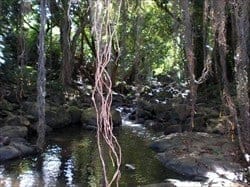USGS discovered insecticides known as neonicotinoids in a little more than half of both urban and agricultural streams sampled across the United States and Puerto Rico, according to a study by the agency published today in Environmental Chemistry.
This study, conducted from 2011 to 2014, represents the first national-scale investigation of the environmental occurrence of neonicotinoid insecticides in agricultural and urban settings. The research spanned 24 states and Puerto Rico and was completed as part of ongoing USGS investigations of pesticide and other contaminant levels in streams.
“In the study, neonicotinoids occurred throughout the year in urban streams while pulses of neonicotinoids were typical in agricultural streams during crop planting season,” said USGS research chemist Michelle Hladik, the report’s lead author.
“The occurrence of low levels in streams throughout the year supports the need for future research on the potential impacts of neonicotinoids on aquatic life and terrestrial animals that rely on aquatic life,” said USGS scientist Kathryn Kuivila, the research team leader. “These results will serve as an important baseline for that future work.”
The foundational study is the first step needed to set priorities for environmental exposure experiments and the potential for adverse impacts to terrestrial and aquatic organisms. Scientists and others have raised concerns about potential harmful effects of neonicotinoids on non-target insects, especially pollinating honey bees and native bees.
In May, the White House released the Strategy to Promote the Health of Honey Bees and Other Pollinators, which includes a Pollinator Research Action Plan.
“This research will support the overall goals of the Strategy, by helping to understand whether these water-borne pesticides, particularly at the low levels shown in this study, pose a risk for pollinators,” said Mike Focazio, program coordinator for the USGS Toxic Substances Hydrology Program.
At least one of the six neonicotinoids tested by USGS researchers was found in more than half of the sampled streams. No concentrations exceeded the United States Environmental Protection Agency’s aquatic life criteria, and all detected neonicotinoids are classified as not likely to be carcinogenic to humans.
Detections of the six neonicotinoids varied: imidicloprid was found in 37 percent of the samples in the national study, clothianidin in 24 percent, thiamethoxam in 21 percent, dinotefuran in 13 percent, acetamiprid in 3 percent, and thiacloprid was not detected.
Use of neonicotinoids to control pest insects has been increasing over the past decade, especially on corn and soybeans. Much of this increase is due to a shift from leaf applications to using the insecticides prophylactically on seeds.
The paper, “First National-Scale Reconnaissance of Neonicotinoid Insecticides in Streams across the USA,” was published in Environmental Chemistry. To learn more about the study, please see our science feature. To learn more about USGS environmental health science, please visit the USGS Environmental Health website and sign up for our GeoHealth Newsletter.


